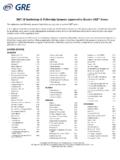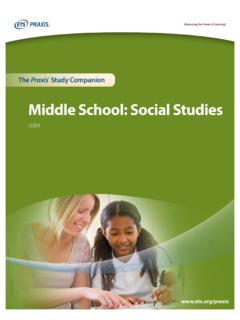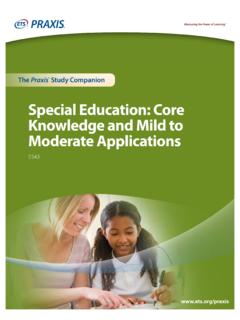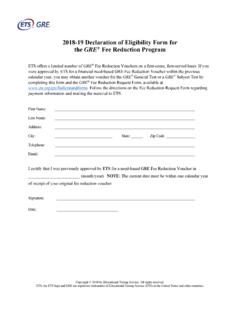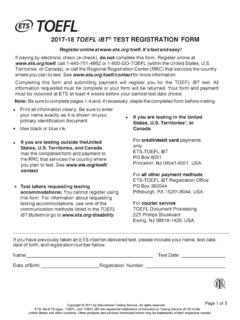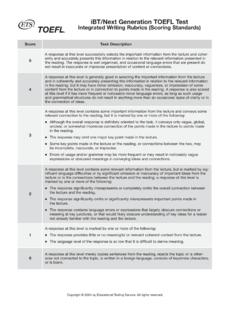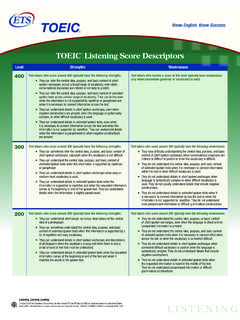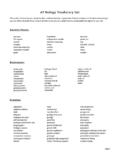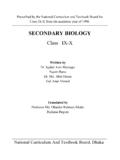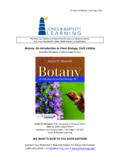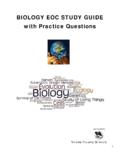Transcription of MAJOR FIELD TEST IN BIOLOGY SAMPLE QUESTIONS
1 MAJOR FIELD TEST IN. BUSINESS. SAMPLE QUESTIONS . MAJOR FIELD TEST IN BIOLOGY SAMPLE QUESTIONS . The following QUESTIONS illustrate the range of the test in terms of the abilities measured, the disciplines covered, and the difficulty of the QUESTIONS posed. They should not, however, be considered representative of the entire scope of the test in either content or difficulty. An answer key follows the QUESTIONS . 2. Cytoplasmic streaming in cells is a phenomenon that (A) depends on intracellular microfilaments (B) depends on extracellular collagen (C) is caused by cilia and flagella (D) occurs only in prokaryotes (E) is absent in green plants 3. A circadian rhythm is best exemplified by the (A) emergence patterns of 17-year cicadas (B) annual migration patterns of monarch butterflies (C) daily activity patterns of a rat (D) scheduled mealtimes of a school child 1.
2 The data in the graph above represents the (E) menstrual cycle of an adult human female population size of the snowshoe hare a prey species in northern Canada and Alaska between 4. Flame cells, green glands, and Malpighian tubules 1850 and 1940. If one assumes that the predator are all specialized structures involved in and prey have mutual density-dependent effects on one another, the curve drawn for the simultaneous (A) digestion population size of the lynx, a predator on the (B) excretion snowshoe hare, would most likely (C) respiration (D) energy transfer (A) have peaks simultaneously with the peaks for (E) reproduction the prey (B) have peaks halfway between the peaks for the 5.
3 All of the following occur as part of the light-independent prey reactions of photosynthesis EXCEPT the (C) have peaks slightly before the peaks for the prey (A) transfer of electrons to ferredoxin (D) have peaks slightly after the peaks for the prey (B) oxidation of water molecules (E) be essentially a horizontal line (C) formation of ADP molecules (D) utilization of photons (E) formation of O2 molecules 6. Compared to a eutrophic lake, an oligotrophic lake 10. The evolutionary process most likely to account tends to have a greater for the fixation of neutral or even nonadaptive allelles or allelle combinations in small (A) supply of oxygen in the deep waters populations is called (B) number of blue-green algae (C) biological oxygen demand (A) recombination (D) amount of hydrogen sulfide (B) Lamarckian selection (E) amount of degradable organic matter (C) Darwinian selection (D) Genetic drift 7.
4 Higher plants have a polar main axis with definite (E) Mutation stem and root ends. This polarity is first established 11. Evolutionary change in both a pollinator and (A) when the seedling first grows into the light a flower resulting from their interaction is an (B) when germination first starts in the soil example of (C) in the embryo of the seed (D) at the time the plant is old enough to produce (A) divergent evolution leaves (B) regressive evolution (E) just before the flower forms on the parent (C) coevolution plant (D) parallel evolution (E) convergent evolution 8. The membranes of mitochondria, chloroplasts, and bacteria are all directly involved with all of the following EXCEPT QUESTIONS 12 and 13.
5 (A) generation of ATP Directions: The following QUESTIONS consist of (B) generation of chemical gradients five lettered headings followed by a list of (C) generation of electrical potentials numbered words, phrases, sentences, or figures. (D) pumping ions against concentration gradients For each numbered word, phrase, sentence, or (E) catalyzing the reactions of the Krebs cycle figure, select the one heading that is most closely related to it and fill in the corresponding oval on 9. Which of the following is released by the placenta the answer sheet. One heading may be used once, and acts to assist in the maintenance of pregnancy? more than once, or not at all in each group.
6 (A) Chorionic gonadotropin (A) Differentiation (B) Vasopressin (B) Determination (C) Thyroxine (C) Pattern formation (D) Luteinizing hormone (D) Induction (E) Oxytocin (E) Plasticity 12. A group of unspecialized embryonic cells is transplanted from a leg bud to a wing bud in the chick embryo, and develops into toes. 13. The lens of the vertebrate eye develops only after the head ectoderm comes in contact with the optic cup. Confidential and Proprietary. Copyright 2014 Educational Testing Service Permission to reproduce this document is hereby granted to institutions (colleges and universities) administering the MAJOR FIELD tests for internal use only. No commercial or further distribution is permitted.
7 Other persons or agencies wishing to obtain permission to reproduce this material may write to the Permissions Administrator at Educational Testing Service, Princeton, New Jersey 08541. QUESTIONS 14-15. Directions: The following QUESTIONS concern a laboratory or experimental situation. In each case, first study the description of the situation. Then choose the one best answer to each question following it and fill in the corresponding oval on the answer sheet. ANSWER KEY. 1. D 9. A. 2. A 10. D. 3. C 11. C. Percent Representation 4. B 12. B. Genotype Residents Emigrants 5. C 13. D. 6. A 14. C. SA SA 42% 18%. 7. C 15. C. SA SB 40% 64% 8. E. SB SB 18% 18%. The table above summarizes the results of a study that examined the allele frequencies (A and B) at a locus S.
8 In a population of resident meadow voles versus individuals that are leaving the population (emigrants). 14. What is the percent frequency of the SB allele in the resident population? (A) 18%. (B) 36%. (C) 38%. (D) 58%. (E) 76%. 15. The study strongly suggests that the allele frequencies in the resident population are changing as a result of (A) mutation (B) genetic drift (C) gene flow (D) acclimation (E) recombination Confidential and Proprietary. Copyright 2014 Educational Testing Service Permission to reproduce this document is hereby granted to institutions (colleges and universities) administering the MAJOR FIELD tests for internal use only. No commercial or further distribution is permitted.
9 Other persons or agencies wishing to obtain permission to reproduce this material may write to the Permissions Administrator at Educational Testing Service, Princeton, New Jersey 08541.
